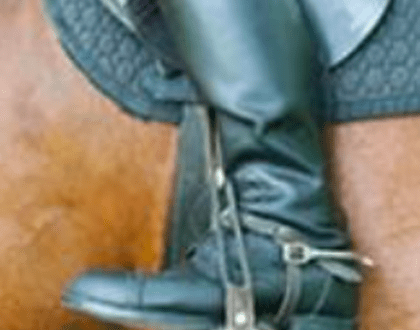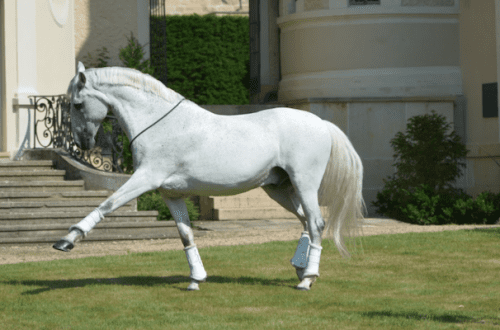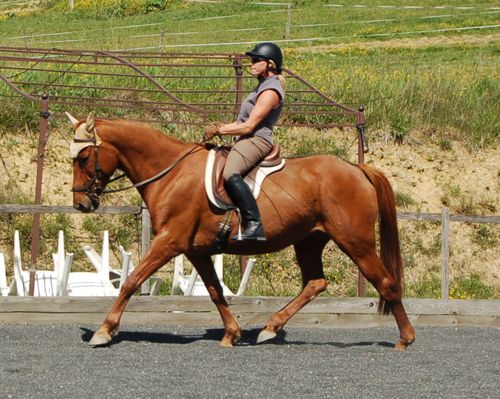
Gymnastics – awareness of yourself on a horse
Gymnastics – awareness of yourself on a horse
There was a time, until about the year 2000, when every riding school paid great attention to gymnastic exercises on horseback. Unfortunately, now this practice has almost sunk into oblivion, and this is sad.
Неоправданно забывать проверенный и надёжный путь к осознанию себя на лошади и осознанию своего равновесия. На протяжении первого года обучения новичка я во время каждого занятия стараюсь уделять 5-15 минут упражнениям. Необходимость зарядки для начинающего всадника очевидна и неоспорима.
Below I will describe the program of gymnastic exercises, which are more than a dozen years old. I will list them in a sequence that will allow you to knead the muscles most harmoniously (from small muscles to larger ones). Usually exercises are performed after the first warm-up trot or before the canter.
It is desirable to save the rider from the need to control the horse – the instructor takes the animal on the cord or leads it on the reins. When moving in a straight line, the exercises are easier to do, but on the lunge, the trainer can better control the process and point out errors to the rider. All exercises are performed without stirrups.
The first block of exercises: “warm-up”
(Performed at walk, subsequently at training trot.)
1. Stretch
We throw the stirrups, put the reins on the horse’s neck. The leg remains lying in the correct position – the heel is lowered down, the toe is turned towards the horse. Schenkel touches the side.
During exercises on the upper part of the body, always follow the correct position of the leg!
We pull the heel down, hands stretch up. The higher, the better. The arms and crown stretch up towards the sky, the heel down towards the earth.
2. Hand rotation
Hands are spread apart, fists are clenched. Rotate fists. Ten times one way, ten times the other.
Далее – кулаки по-прежнему сжаты, rotate the arm from the elbow. We firmly fix the shoulders perpendicular to the body, rotate only by hand from the elbow. Ten times one way, ten times the other.
Rotate completely by hand. At the same time, we try to keep our back straight, the lower back is bent, we do not swing the body. Ten times one way, ten times the other.
What for? To separate body parts from each other! After all, when we control a horse, we first give a command with our fingers, then we strengthen it with our wrist. If the horse does not respond, the arm from the elbow is turned on. In case of severe disobedience (the horse was driven into the bushes), the arm from the shoulder is turned on, the shoulder is used as a lever. But, if we immediately begin to pull the reins with our whole hand, it will be rude and incorrect in relation to the animal!
3. Toe rotation
Hands on the belt, the knee is pressed, the leg is at the side. We describe circular movements with socks – ten times in one direction and ten in the other. Be sure to repeat when moving in one direction and in the other.
What for? This exercise helps catch the stirrups without compromising the fit. By the way, throwing and catching stirrups is also very useful – at a walk, at a trot and even at a gallop.
4. Swing legs from the knee
Сидим ровно, колени прижаты. Ногами от колена (обоими одновременно) выполняем махи вперёд и назад. Максимально вперёд и максимально назад. Стараемся не пинать лошадь в бока – делая мах назад, немного отводим ногу в сторону. Выполняем упражнение двадцать раз.
What for? This exercise helps to realize the correct relationship of muscles when sending. During the exercise, the body is not involved, we sit deep in the saddle, completely relaxed. Only the legs move from the knee. The process does not include arms, no back, no lower back. When we learn to send a horse, the movement should be essentially the same – only the foot remains in place.
5. Head rotation
An extremely useful exercise! We sit without stirrups, relaxed, legs in the correct position, hands on the belt. Rotate your head clockwise and counterclockwise – five times in each direction. You can close your eyes, you can not close – as you like. We try not to lose balance and not fall to the side.
What for? The best exercise for the vestibular apparatus and the feeling of the horse is difficult to come up with.
6. Turns
We sit straight, pull the heels down, arms to the sides. We turn the body as much as possible to the left and as much as possible to the right. Slowly, thoughtfully and calmly stretch in each direction ten times.
What for? To separate the work of the body from the legs. This exercise, like the previous one, improves balance and the vestibular apparatus, strengthens the back muscles.
The second block of exercises: “gymnastics”
(First performed on a standing horse, then on a walk.)
7. Tilts on the horse’s neck
Hands on the belt, legs in the correct position, back straight. We lean on the neck of the horse – it is advisable to get the chin to the mane. We don’t help with our hands, we don’t hold on to the horse with our legs and heels. We rest against the knee and strain the leg – as if we are pulling it forward so as not to cause discomfort to the animal. Ten slopes.
With children, instead of bending over the neck, you can do the exercise “we stretch to the ears of the horse” – it’s easier, clearer and more fun for them to perform it.
What for? This exercise strengthens the abdominals and back; in addition, it teaches you to keep your foot in place, regardless of the movements of the body. Bending back is also a very useful exercise, but I avoid it so as not to overload the horse’s back. Still, first of all, you need to think about the animal so that it does not complain about anything and does not feel negative towards the rider.
8. Stretch to socks
We sit straight, heels down, legs in place. Raise your right hand up. We bend down and reach for the toe of the left foot. It is advisable to reach the sock. We pay special attention to pulling the hand to the leg, and not vice versa! Feet should lie strictly in place! Including the leg on the opposite side.
We got to the toe – we sit down evenly, raise our left hand up and reach for the toe of the right foot. Alternately five times in each direction. At first, you can hold the saddle with your other hand.
What for? Great exercise for balance and flexibility.
9. Clap your feet over the horse’s neck
We hold on to the back pommel of the saddle with both hands, sharply clap with straight legs above the horse’s neck. The faster you do this exercise, the easier it will be. It is important that the legs are straight and fully touching, including the heels.
Subsequently, this exercise can be performed on the step and without hands.
What for? Develops a sense of balance, courage, self-confidence. Almost any beginner can complete this exercise in the first lesson. However, not everyone should immediately offer to fulfill it.
It’s important: the animal must not shy away, so it must be prepared!
10. Clapping your feet over the horse’s croup
We lean our hands on the front pommel of the saddle, sharply lean forward and at the same time clap with straight legs from behind over the horse’s croup. The legs should also be straightened and touch along the entire length.
What for? Improves balance and coordination. For more advanced riders. You can start trying this exercise at 5-7 sessions, but do not demand too much.
Third block: additional exercises
Over the years, ten, in my opinion, the most effective exercises remained in the program of my classes. However, there are many more … Next – some ways to diversify the workout.
12. Подъёмы коленей
Сидим ровно, держимся за заднюю луку седла. Поочерёдно подтягиваем колени к груди. По пять раз правое и левое; пять раз одновременно. Впоследствии можно выполнять без рук.
13. Swing legs
We sit straight, hold on to the back pommel of the saddle. We transfer the straight left leg through the neck of the horse, touch the saddle, as if sitting down “like a lady”, straighten it again and transfer it back. The same with the right foot. Confident riders swing without pause, moving their legs one after the other at the same time. Can be done without hands.
14. Scissors
For advanced riders.
We perform clap with our feet over the croup of the horse, at the top point we cross our legs and sit back to front.
15. Pinwheel
For advanced riders.
We throw the right leg to the left side, sit down “like a lady.” With the right hand we hold on to the back pommel of the saddle, with the left hand – on the front. Leaning on our hands, we turn over with our stomach to the horse and immediately swing our right leg over the croup, sitting in the saddle. We repeat the same mirror on the left side. The horse must be pre-prepared so as not to shy away. Particularly dexterous riders can perform this exercise on the walk.
Пару слов о стременах
Одно из самых полезных упражнений, развивающих баланс, координацию движений и равновесие, – бросать и снова ловить стремена. Это упражнение я не буду относить к какому-то определённому блоку, так как его можно и нужно выполнять как можно чаще, на всех трёх аллюрах.
The bottom line is that the rider takes his legs out of both stirrups, and then, without looking down and without helping himself with his hands, catches them in the correct position. It makes sense to do at least 5-10 repetitions in a row. Each time the stirrup is on the foot, we fix it with the foot in the right place (where the toes begin), pull the heel down and put the leg in the correct position. Only then we take out the leg again.
Secret exercises simple: legs should not hang out and convulsively “search” for stirrups. If you sit correctly, the stirrups will find you!
Часто у начинающего всадника возникает страх потери стремян. Однако всё, что мы делаем со стременами – включая прыжки и полевую посадку – можно точно так же выполнять без стремян. Не должно быть психологической привязки: стремя = комфорт.
But you should remember that getting used to riding without stirrups is quite simple. Then the opposite problem may arise – the stirrup will fly off the leg and live its own life.
This exercise solves both of the above problems – it removes the psychological clamp on the loss of the stirrup, and also minimizes the likelihood that the legs and stirrups will function separately from each other.
There is очень «детское» упражнение, the effectiveness of which amazes and exceeds all expectations. You can put rings 10-20 cm in diameter on the socks of the rider.
task, at first glance, elementary: hold the rings so that they do not fall. To do this, the rider is forced to raise his toes and lower his heels. It is difficult for young children to explain how to keep their legs in the correct position in a different way. Such an easy task first touches an adult rider, and then … it turns out that everything is not so simple. Try to push the horse with your leg so that the ring does not fly off the leg! Or sit with the rings on the training trot for at least a couple of circles … Believe me, this exercise really works wonders!
Riding in different positions
It is very important, useful and, it seems to me, simply necessary to ride a horse in different positions – especially in the early stages of training. This helps to understand how the horse moves, helps to learn to listen to him and feel the balance.
1. Riding «more ladylike»
On a standing horse, we change “lady-like” to the inside of the circle. If the horse is riding to the left, we throw the right leg over the front pommel and put it on the horse’s shoulder, in front of the saddle wing. At first, you can stick with your hands on the mane or saddle, but only in front. When driving “like a lady” you can’t hold on to the back pommel!
Начинаем двигаться шагом. Центр тяжести должен быть чуть больше смещён на внешнюю сторону – иначе вы просто спрыгнете на ноги. Когда немного освоитесь, можно брать в руки повод. Совсем уверенным всадникам можно попробовать ехать рысью.
Everything related to side transfers and other asymmetrical exercises should be repeated equally to the left and right – so that the rider and horse develop evenly, without overloading one or the other side.
By the way, when training with men, I try to avoid the words “lady-like transfer”, replacing them with the words “side-transfer” – although, in fact, riding sideways looks a little different.
2. Riding sideways
The “sideways” position differs from the “lady” position in that the rider does not sit in half a turn, but perpendicular to the movement of the horse. This exercise is best performed without a saddle, but remember that it is not very pleasant for the horse. Therefore, I offer it mainly to children.
3. Driving backwards
On a standing horse, the rider changes back to front. The animal starts walking. It is important to monitor the center of gravity, do not put your legs far forward. You don’t have to hold on to the saddle. When you get comfortable, you can take the reins in your hands. It is very useful to ride in different directions, change direction yourself, make a few volts.
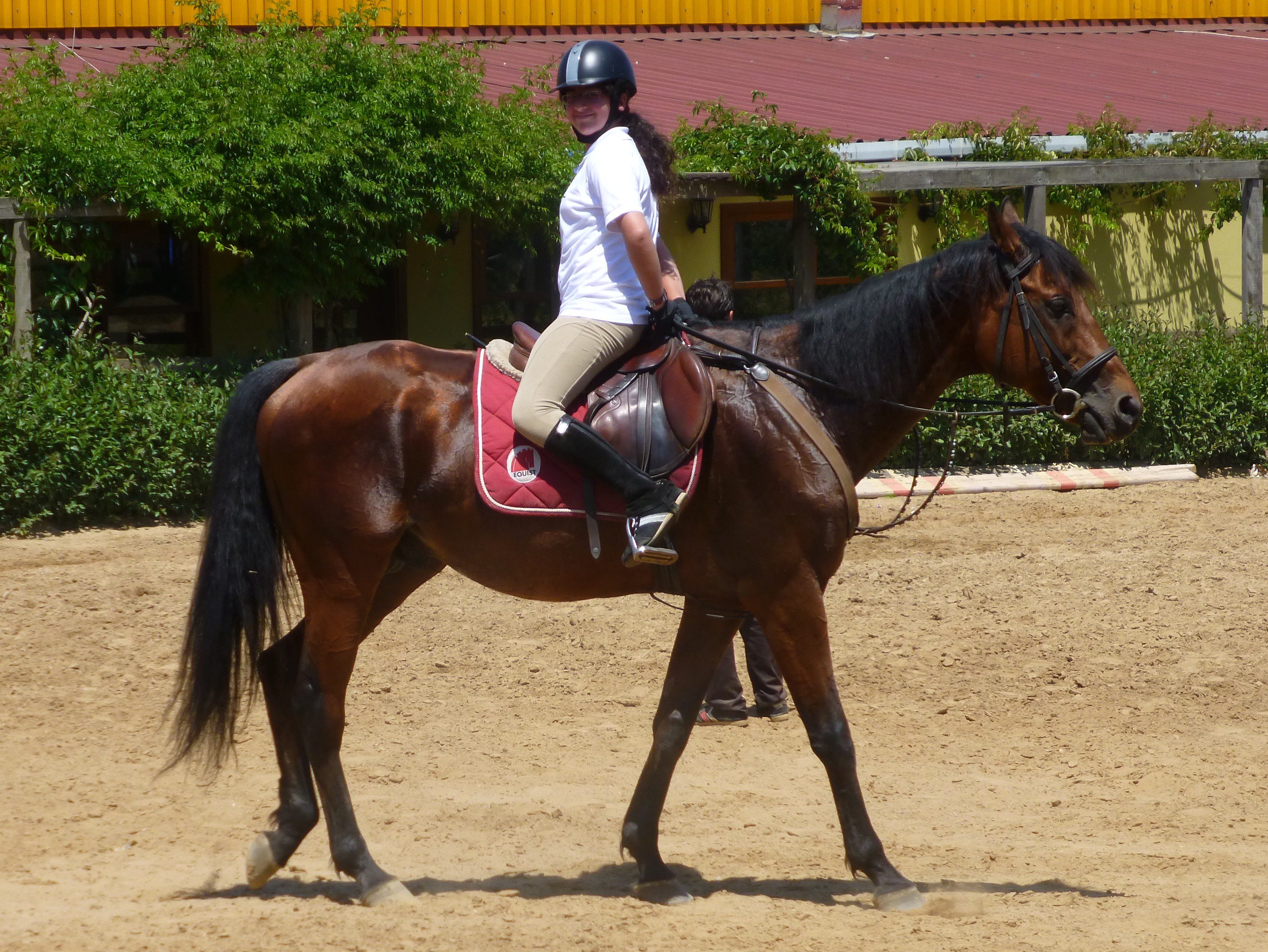
С детьми можно поиграть в мяч, в ладушки, или разрешить подержать лошадку за хвост. Естественно, конь должен быть к этому соответственно подготовлен.
4. Full circle
This exercise can be performed on a standing or walking horse. The rider changes non-stop, without stopping in each position: sideways, backwards, sideways in the other direction, again on horseback. Be sure to repeat left and right.
5. Lying on a horse
A wonderful exercise to relax and feel the horse. You can do it at the end of charging. Of course, it is more convenient and better to perform it without a saddle. However, the saddle is not a hindrance if it does not have very high front and back pommel.
We lie down on the horse’s neck (the legs remain in place), we hang our arms on the sides. Enjoy the movements of the horse.
Gently lean back on your back, hang your arms. You can close your eyes. Enjoy. We try to lie in the middle of the horse, along its spine.
Пересаживаемся задом наперёд и ложимся на круп.
Можно полежать на животе, поперёк лошади. Важно почувствовать баланс, чтобы не спрыгнуть на ноги и не «нырнуть» головой вниз.
Very carefully, on a standing horse, you can try to lie on your back across the horse. Better without a saddle. This exercise is great for stretching the spine, but be careful. A few seconds of balance in this position is enough. The main thing is to completely relax!
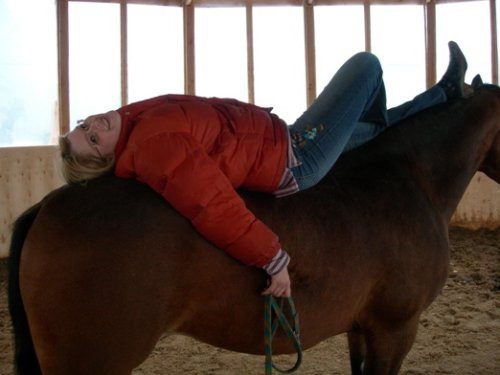
I want to emphasize once again the importance of gymnastics on a horse. This is a proven and reliable way to a strong, relaxed landing! Even if your trainer does not practice such exercises, it is worth asking him about it. Or, if you’re untrained, have a friend lead your horse on the bit for a few minutes while you practice the basics of vaulting. However, remember: the horse must adequately perceive the unusual movements of the rider on his back.
Good luck and have a good landing!
Ksenia Krotova, horse riding and hippotherapy instructor.
Excerpt from a book “Horse, rider, instructor: how to understand each other?”




